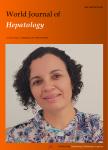Malnutrition negatively impacts the quality of life of patients with cirrhosis: An observational study
Malnutrition negatively impacts the quality of life of patients with cirrhosis: An observational study作者机构:Liver ClinicGastroenterology DepartmentHospital General de México“Dr.Eduardo Liceaga” Internal Medicine DepartmentHospital General de México“Dr.Eduardo Liceaga” Gastroenterologist at Lakeland Regional Medical Center
出 版 物:《World Journal of Hepatology》 (世界肝病学杂志(英文版)(电子版))
年 卷 期:2017年第9卷第5期
页 面:263-269页
主 题:营养不良 主观全球评价 生活的健康相关的质量 肝硬化 长期的肝疾病问询表
摘 要:AIM To verify how malnutrition is related to health-related quality of life(HRQL) impairment in patients with cirrhosis.METHODS Data was retrospectively abstracted from medical records and obtained by direct interview. We included patients with cirrhosis from any etiology, evaluated at the Liver Clinic from Gastroenterology Department in a tertiary healthcare center, from June 2014 to June 2016. Child-Pugh score, data about complications, and demographic, clinical and anthropometric characteristics of patients were obtained. Nutritional status was evaluated by the Subjective Global Assessment(SGA). HRQL was evaluated through the Chronic Liver Disease Questionnaire. Patients were requested to assess their global HRQL with the following code: 0 = impairment of HRQL, when it was compared with other healthy subjects; 1 = good HRQL, if it was similar to the quality of life of other healthy subjects. To compare the primary outcome between malnourished and well-nourished groups, the χ~2 test, Fisher s exact test or Student s t-test were used, based on the variable type. Associations between predictor variables and deterioration of HRQL were determined by calculating the hazard ratio and 95% confidence interval using Cox proportional hazards regression. RESULTS A total of 127 patients with cirrhosis were included, and the mean age was 54.1 ± 12.3 years-old. According to Child-Pugh scoring, 25(19.7%) were classified as A(compensated), 76(59.8%) as B, and 26(20.5%) as C(B/C = decompensated). According to SGA, 58(45.7%) patients were classified as well-nourished. Sixty-nine patients identified HRQL as good, and 76 patients(59.8%) perceived impairment of their HRQL. Multivariate analysis to determine associations between predictor variables and self-perception of an impairment of HRQL found strong association with malnutrition(P 0.0001). The most important impaired characteristics in malnourished patients were: Presence of body pain, dyspnea on exertion with daily activities, decreased appetite, generalized weakness, trouble lifting or carrying heavy objects, and decreased level of energy(P 0.0001).CONCLUSION Malnutrition is a key factor related to impairment of HRQL in patients with cirrhosis.



